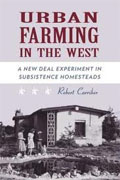Urban Farming in the West
Robert M. Carriker
book reviews:
· general fiction
· chick lit/romance
· sci-fi/fantasy
· graphic novels
· nonfiction
· audio books
· author interviews
· children's books @
curledupkids.com
· DVD reviews @
curledupdvd.com
newsletter
win books
buy online
links
home
for authors
& publishers
for reviewers

 |
Urban Farming in the West: A New Deal Experiment in Subsistence Homesteads Robert M. Carriker University of Arizona Press Hardcover 304 pages February 2010 |
|
In the late 1930s, Franklin and Eleanor Roosevelt engineered a small but memorable homesteading initiative that spread across America--the last real pioneering effort in response to the privations of the Great Depression. The initiative was managed in part by the Division of Subsistence Homesteads, a New Deal agency which, like all New Deal agencies, was hydra-headed, often causing confusion in the ranks about purview and responsibilities. Nonetheless, the overweening ideal that characterized all the New Deal homestead projects was to re-house and re-energize economically deprived families by offering them a fresh start: house, land and basic subsistence. The rest would be up to them.
In each case, prospective residents were vetted carefully by the DSH. It is now understood that whereas the progressives of the era generally strove to promote racial tolerance in many spheres, housing projects were an exception, and the injunction to make sure that the population of the planned homesteads matched that of the local demographic was tacitly racist. In general, Native Americans and Hispanics were left out of the projects. In all, only a handful of homesteads in the US were set aside for African Americans, and one for Jews. To qualify for the project, a family had to be able-bodied and of good character as established by such means as examination by doctors and social workers and letters from pastors. Some projects were restricted as to religion. Carriker's book includes many poignant letters written by hard-hit citizens to the DSH, and even to the President and First Lady, begging for a chance to have one of the little modest homes and modest farm plots on offer. In practice, the idealism behind the homesteads proved flawed. A common complaint was that city folks didn't want to do the requisite farm work. Longview was conceived as a demonstration site, and "the seemingly non-stop flow of visitors took its toll.” Some participants felt the federal oversight was too strict and all-pervasive. Nonetheless, after the first year, the residents at Longview sent the President a heartfelt letter of appreciation. Once World War II was underway, the homestead residents, wherever located, could get good jobs elsewhere. As Carriker points out, "when times got better, the devotion to the home production of food fell dramatically." The New Deal homesteads were set up to get people back to the land (or in some cases, to bring land to the cities in the form of greenbelts) and to reinvest ordinary Americans with an interest in home crafts and self-sufficiency. Even Roosevelt was put off by the notion of "subsistence" and wanted to replace it with something like "the more abundant life." In the end, residents opted for their own individual views of that more abundant life. Some bought their homesteads when the federal agencies divested ownership, and some have stayed on to the next generation, indicating a strong sense of community that was engendered by the projects. That in itself is remarkable, considering that the participants were not chosen for their former cohesiveness but at random. They made the projects work, one could say, in spite of the planners. But, as Carriker points out, the fact that the Western communities still exist is a credit to the planners, too. Originally published on Curled Up With A Good Book at www.curledup.com. © Barbara Bamberger Scott, 2012 |
|
|
|
 Click here to learn more about this month's sponsor! |
|
| fiction · sf/f · comic books · nonfiction · audio newsletter · free book contest · buy books online review index · links · · authors & publishers reviewers |
|
| site by ELBO Computing Resources, Inc. | |
 That this new chance for independence was overseen so strictly as to promote dependence was not always acknowledged fully but presented the designers with a paradox from the start. Robert M. Carriker, director of Public History Studies at the University of Louisiana at Lafayette, has done his research and threaded his way through the spaghetti of government acronyms and the shifting cast of characters involved with the DSH, highlighting four Western homestead projects: Phoenix Homestead, El Monte and San Fernando in California, and Longview, Washington.
That this new chance for independence was overseen so strictly as to promote dependence was not always acknowledged fully but presented the designers with a paradox from the start. Robert M. Carriker, director of Public History Studies at the University of Louisiana at Lafayette, has done his research and threaded his way through the spaghetti of government acronyms and the shifting cast of characters involved with the DSH, highlighting four Western homestead projects: Phoenix Homestead, El Monte and San Fernando in California, and Longview, Washington.